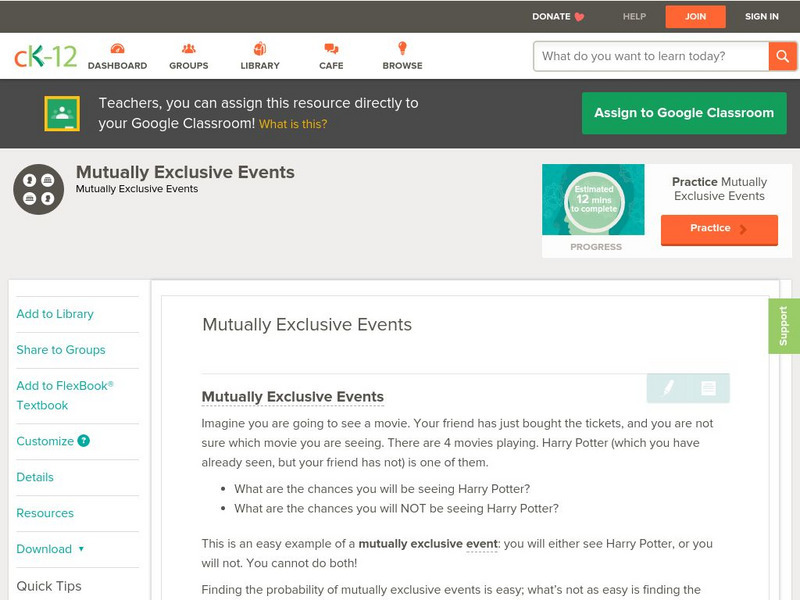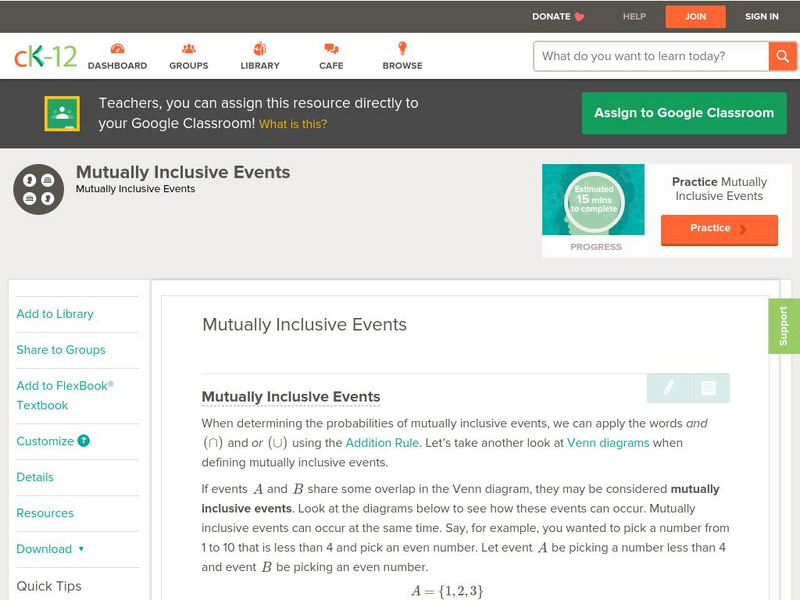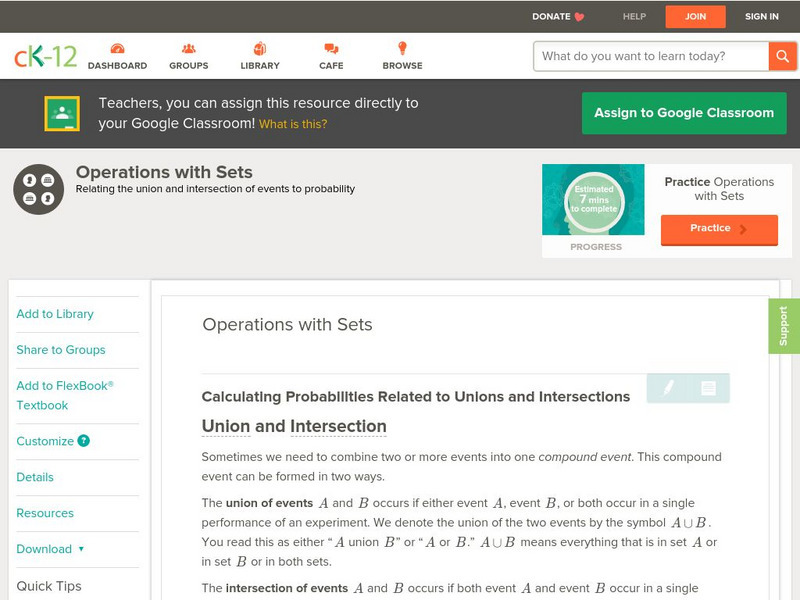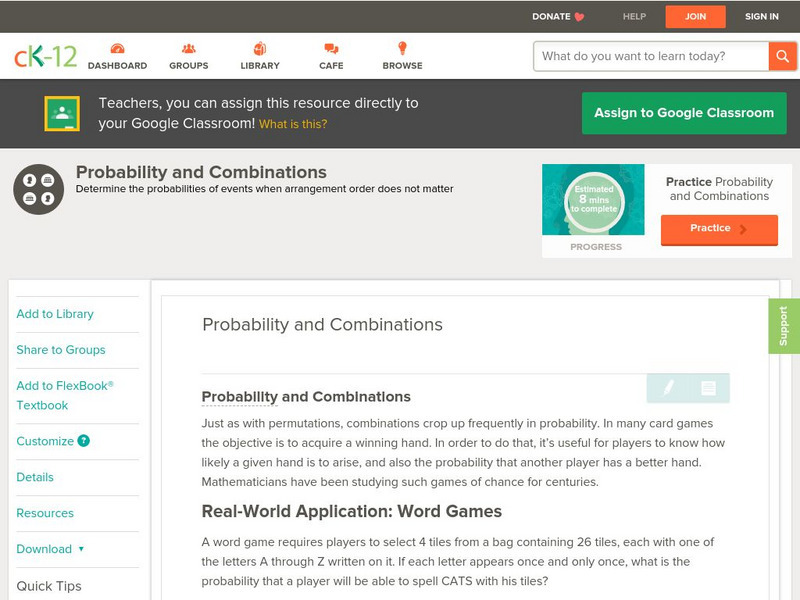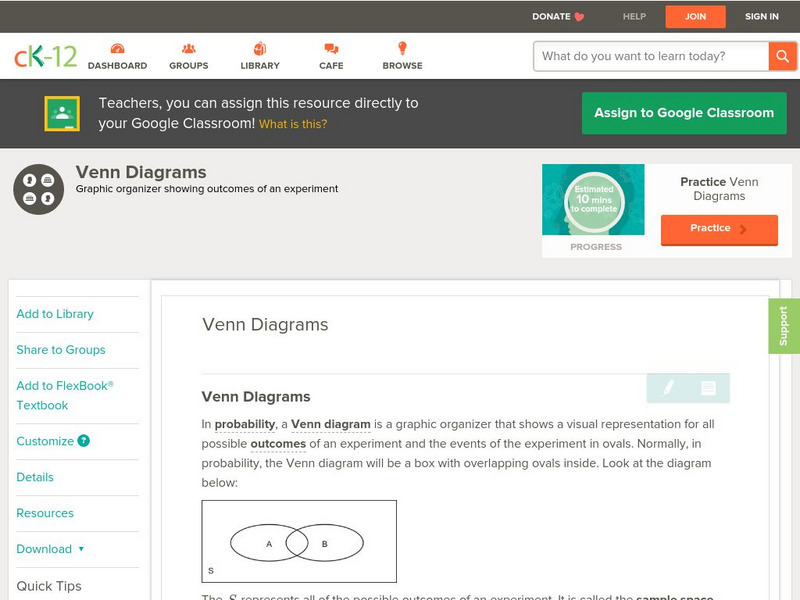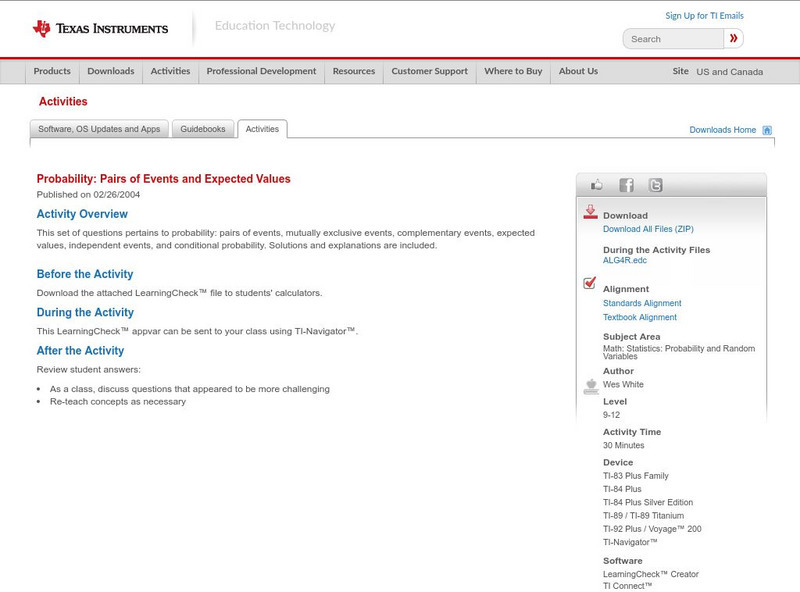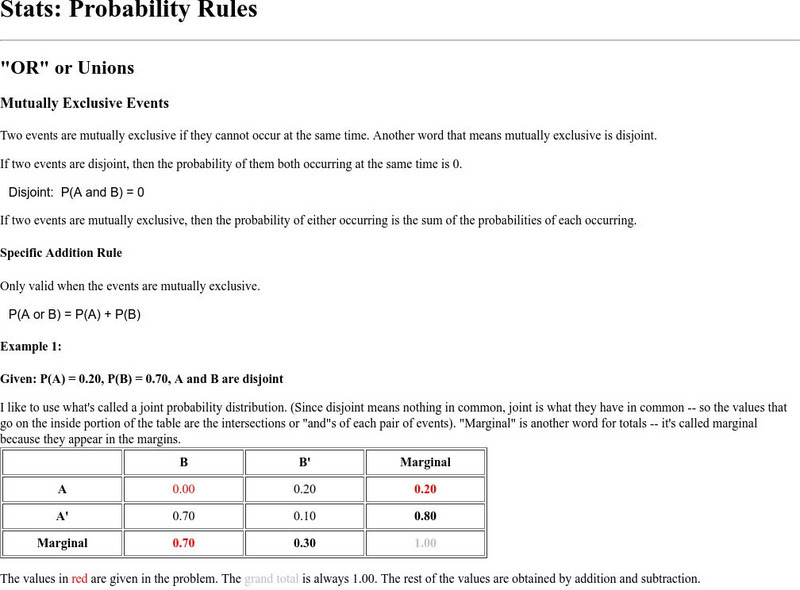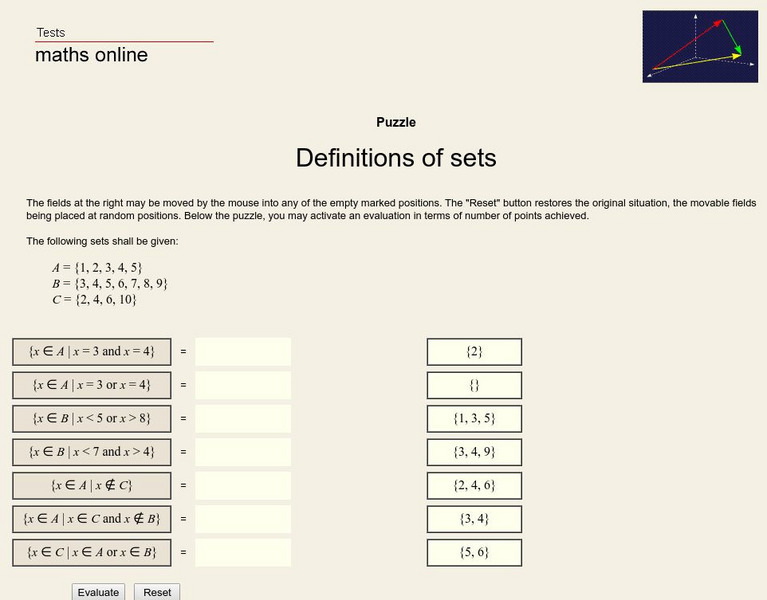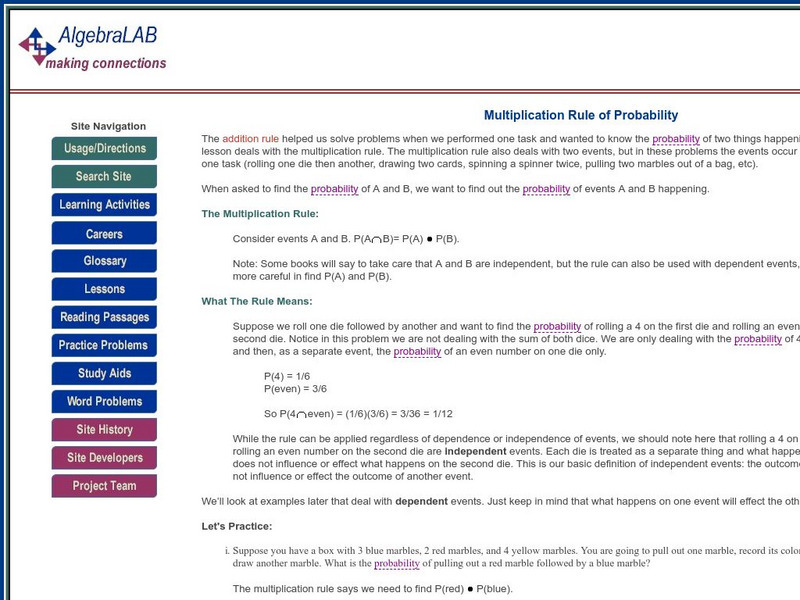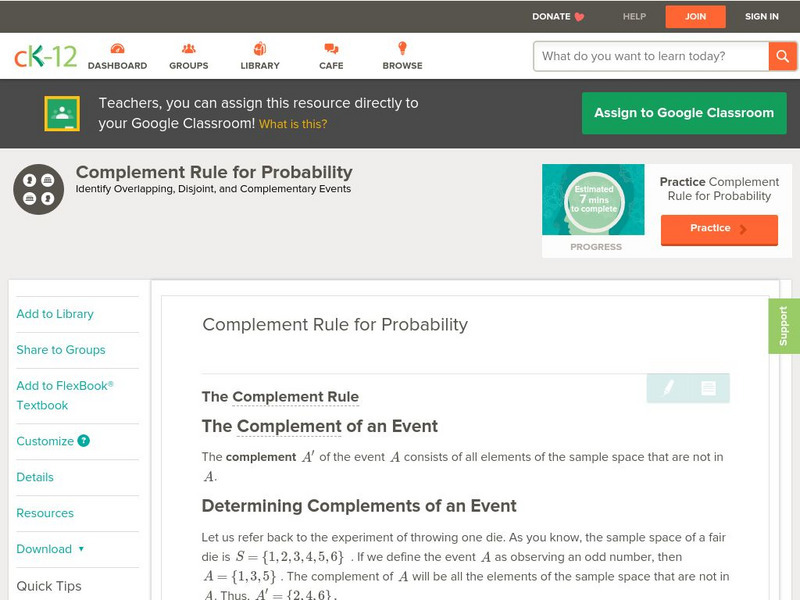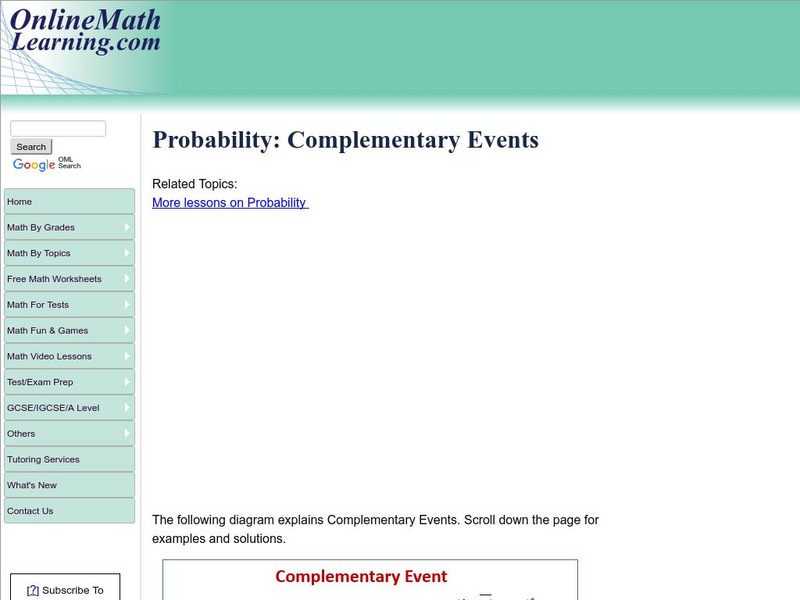CK-12 Foundation
Ck 12: Probability: Mutually Exclusive Events Grades 9 10
[Free Registration/Login may be required to access all resource tools.] Recognize disjoint events as having no outcomes in common.
CK-12 Foundation
Ck 12: Probability: Mutually Exclusive Events Grades 9 10
[Free Registration/Login may be required to access all resource tools.] Find the probability of a series of events that can occur at the same time and of those that cannot.
CK-12 Foundation
Ck 12: Probability: Mutually Inclusive Events Grades 9 10
[Free Registration/Login may be required to access all resource tools.] Recognize overlapping events as having one or more outcomes in common.
CK-12 Foundation
Ck 12: Probability: Operations With Sets
[Free Registration/Login may be required to access all resource tools.] This Concept teaches students how to find unions and intersections, as well as to calculate the probabilities of of these sets.
CK-12 Foundation
Ck 12: Probability: Probability and Combinations Grades 9 10
[Free Registration/Login may be required to access all resource tools.] Use combinations to determine the probability that a specific event will occur.
CK-12 Foundation
Ck 12: Probability: Tree Diagrams Grades 10 12
[Free Registration/Login may be required to access all resource tools.] This lesson covers Tree Diagrams, combinations or permutations to determine the probabilities of multiple events and probability distributions.
CK-12 Foundation
Ck 12: Probability: Venn Diagrams Grades 9 10
[Free Registration/Login may be required to access all resource tools.] Covers the definition of Venn diagrams and how to use them.
CK-12 Foundation
Ck 12: Probability: Mutually Exclusive Events Grades 9 10
[Free Registration/Login may be required to access all resource tools.] Find the probability of a series of events that can occur at the same time and of those that cannot.
CK-12 Foundation
Ck 12: Probability: Venn Diagrams
[Free Registration/Login may be required to access all resource tools.] Covers the definition of Venn diagrams and how to use them.
Texas Instruments
Texas Instruments: Probability: Pairs of Events and Expected Values
This set of questions pertains to probability: pairs of events, mutually exclusive events, complementary events, expected values, independent events, and conditional probability. Solutions and explanations are included.
Richland Community College
Stats: Probability Rules
This site provides the rules for mutually exclusive events, non-mutually exclusive events, independent events, and dependent events for probability.
Purple Math
Purplemath: Set Notation
This resource explains concepts related to set notation and gives examples for each.
University of Vienna (Austria)
University of Vienna: Definition of Sets
Assess understanding of sets by matching each set notation with its corresponding set.
Cool Math
Coolmath: Combinations
This algebra lesson explains combinations - how to count how many ways n objects can be chosen r at a time.
Khan Academy
Khan Academy: Subsets of Sample Spaces
Answer interesting questions about subsets of sample spaces. Students receive immediate feedback and have the opportunity to try questions repeatedly, watch a video or receive hints.
Khan Academy
Khan Academy: Basic Set Notation
Checks understanding of the union, complement, and intersection of sets. Students receive immediate feedback and have the opportunity to try questions repeatedly, watch a video or receive hints.
CK-12 Foundation
Ck 12: Mutually Inclusive and Mutually Exclusive Events
[Free Registration/Login may be required to access all resource tools.] Learn about mutually inclusive and exclusive events in probability.
Illustrative Mathematics
Illustrative Mathematics: The Addition Rule
The purpose of this task is to provide practice calculating probabilities in the context of a chance experiment with equally likely outcomes and to allow students to develop the addition rule for calculating the probability of the union...
Illustrative Mathematics
Illustrative Mathematics: Describing Events
The purpose of this task is to review the definitions of sample space and events. Students are asked to describe events both verbally and as subsets of a sample space. Aligns with S-CP.A.1.
Other
Algebra Lab: The Multiplication Rule of Probability
An explanation with examples of how to calculate probabilities of two dependent or independent events by multiplying their probabilities. Practice problems are provided along with their explanations.
CK-12 Foundation
Ck 12: Complement Rule for Probability
[Free Registration/Login may be required to access all resource tools.] An explanation of complementary events in probability including Determining Complements of an Event, The Complement Rule including a video [9 mins, 40 secs], Using...
OnlineMathLearning.com
Online Math Learning: Probability: Complementary Events
An explanation of complementary events in probability along with several examples and step-by-step solutions.
Khan Academy
Khan Academy: Dependent Probability
Find dependent probabilities like P(A | B) or P(B | A) for a variety of contexts. Students receive immediate feedback and have the opportunity to try questions repeatedly, watch a video or receive hints.
Other
Probability Formula: Complementary Events
An explanation of complementary events in probability including the formula and an example.



